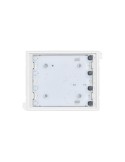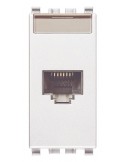- HOW TO DO
- 3 likes
- 15751 views
- 0 comments

Meaning and Table of IP Protection Degrees: IP65, IP44, IP54
What are IP Protection Ratings?
The IP protection rating , also known as the international protection marking , represents an essential standard for electrical devices. Although it is sometimes incorrectly called "entry grade", in reality, the acronym IP stands for "International Protection" or "Ingress Protection".
The CEI EN 60529/1997 standard
The CEI EN 60529/1997 standard, previously referred to as CEI 70-1, is the official regulation that describes the classification of the different degrees of protection for electrical devices. This classification was developed by the International Electrotechnical Commission (IEC) with reference to the IEC 60529 standard.
How are IP Protection Degrees classified?
The different IP protection degrees are distinguished by their resistance to the intrusion of solid and liquid bodies. Each IP rating is indicated with a combination of numbers and letters that describe the level of resistance offered:
- The first number indicates protection against the ingress of solid bodies and resistance to dust.
- The second number represents protection against liquid ingress and is an indicator of the waterproof level.
The IP classification is particularly important in contexts where devices are exposed to adverse environmental conditions, requiring certified protection to operate safely.
Examples of Common IP Protection Ratings
IP65
The IP65 rating guarantees complete dust protection and the ability to withstand water jets from all directions, making the device protected and safe even when exposed to liquid elements.
IP44
With the IP44 rating, the device is protected against objects larger than 1mm and splashes of water from all directions, making it ideal for indoor environments where occasional splashes may occur.
IP54
The IP54 rating, on the other hand, offers protection against dust in quantities not sufficient to compromise the operation of the equipment and against splashes of water, making it suitable for applications in environments with slight exposure to dust and humidity.
When implementing a compliant electrical system , it is essential to consider the correct IP classification of the devices used, to ensure not only compliance with regulations, but also maximum safety and reliability over time.
What is the IP Protection Rating?
The IP protection rating, or International Protection , is indicated by 2 letters followed by a series of numbers and, in some cases, additional letters. These combinations provide precise information on the ability of a device to resist the penetration of solid and liquid bodies. Common examples of such codes include IP65, IP44, IP55, IP20, IP64, among others, each representing a specific protection class.
How to Crack the IP Code
Let's consider for example IP67CH : the code begins with "IP" which stands for International Protection or "ip protection" in English. The numeric portion follows, with the first digit ranging from 0 to 6 (or "x"), and the second digit ranging from 0 to 8 (also "x"). Finally, the two additional letters can be A, B, C or D for the first, and H, M, S, W for the second.
Interpretation of the IP Code: Example IP67CH
Cracking an IP code may seem complicated at first, but with the right guidance it becomes easier. To make it easier to understand, I have created two reference tables that you can print for future use. The first digit, in our example the 6 of IP67CH, indicates the level of protection against solid ingress, while the second digit refers to the resistance to the ingress of liquids.
Guide to the Classification and Meaning of IP Protection Degrees
Meaning of the 1st Number After the IP Abbreviation
The first number following the IP acronym indicates the level of protection that an enclosure provides against access to dangerous parts (e.g. electrical components) and the entry of solid foreign bodies.
- 0 or X: No protection.
- 1: Protection from solid bodies with a diameter greater than or equal to 50 mm.
- 2: Protection from solid bodies with a diameter greater than or equal to 12 mm.
- 3: Protection from solid bodies with a diameter greater than or equal to 2.5 mm.
- 4: Protection from solid bodies with a diameter greater than or equal to 1 mm.
- 5: Protection against harmful dust accumulation.
- 6: Total protection against dust entry.
Meaning of the 2nd Number After the IP Abbreviation
The second number provides the enclosure's level of protection against liquid ingress.
- 0 or X: No protection.
- 1: Protection against vertically falling drops of water.
- 2: Protection against falling drops of water with an inclination of up to 15° from the vertical.
- 3: Protection from water sprayed up to 60° from the vertical.
- 4: Protection from splashes of water coming from all directions.
- 5: Protection against low pressure water jets from any direction.
- 6: Protection against high pressure water jets.
- 7: Protection against the effect of temporary immersion in water.
- 8: Protection against prolonged immersion in water.
Analyzing the IP67 rating, for example, we note that the device is totally protected against the ingress of dust (6) and can be temporarily immersed in water (7). Further details, including additional protection levels, may be indicated by additional letters following the IP rating.



Comments (0)